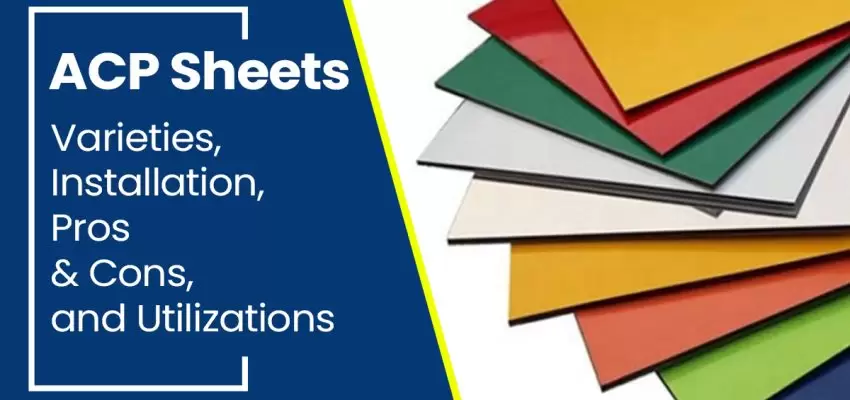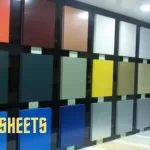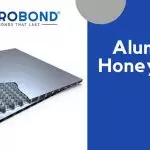When you’re picking for your home improvement job, there are a few important things to think about. In this blog, we will explore Aluminum Composite Panels, covering everything from different types to installation, the pros and cons, and the countless ways you can use them to enhance your surroundings.
Post your Requirement
What Are ACP Sheets?
The full form of ACP is an Aluminum Composite Panel. It’s made of two thin-coated aluminum panels. They work well because they combine a metal (aluminum) with a non-metal (polyethylene plastic). They are used for building exteriors, interiors, and signage. ACP panels come in various colors and finishes like wood, stone, gloss, and pebble. They are versatile and can be shaped in ways other materials can’t. ACP panels are thoroughly tested for quality.
Varieties Of ACP Sheets
Broadly ACP Panels are categorized into 2 types:
- Non-Fire Class ACP Panel:
- Made of two thin aluminum layers with a polymer core.
- Core materials are usually LDPE or polyurethane.
- These panels are flammable and not fire-resistant.
- Limited use due to their fire risk.
- Fireproof ACP Panel:
- Can endure fires for up to 2 hours.
- The core is made from fire-resistant materials, like magnesium hydroxide.
- Offers better flame resistance.
- Suitable for locations requiring fire protections.
ACP Panel come in different varieties, serving diverse purposes in construction. Some of their varieties are stated below :
- Cladding Panels, 3D Wall Panels, Wall Panel, PVC Wall Panel, and Cladding Sheets enhance aesthetics.
- WPC Wall Panel and Structural Glazing System offer durability.
- Curtain Walls, Corian Facade, and Cladding Tiles provide functional and stylish options for building exteriors.
Installation Process For ACP Sheets
These steps will guide you through the ACP sheet installation process, ensuring a successful and professional outcome.
- Surface Preparation
-
-
- Ensure the installation surface is clean, dry, and free of dirt or debris.
- Make any necessary repairs to create a smooth and even surface.
- Accurate Measurements: Measure the area accurately using a measuring tape and level to determine the panel sizes.
-
- Cutting ACP Panels: Use an electric saw or panel cutter to cut ACP panels to match the measured dimensions, following safety guidelines.
-
- Attachment Method: Choose between mechanical or adhesive fixing methods for attaching ACP panels.
- Mechanical Fixing:
- Place the cut ACP panel on the prepared surface.
- Secure the panel by drilling holes through it and into the surface.
- Insert screws and tighten them.
- Repeat for each panel, ensuring proper alignment and spacing.
- Adhesive Fixing:
-
- Apply high-quality adhesive tape or sealant to the back of the ACP panel.
- Carefully position the panel on the surface with proper alignment.
- Press the panel firmly for a strong bond.
- Use clamps or brackets to hold panels in place until the adhesive sets.
- Repeat for each panel, maintaining uniform spacing.
Pros And Cons Of Using ACP Sheets
Below we have mentioned the pros and cons of using ACP Sheets:
|
S.No. |
Pros |
Cons |
|
1. |
Aesthetically pleasing, enhancing the appearance of structures. |
Color and finish may fade over time. |
|
2. |
Lightweight, facilitating transportation and installation. |
Susceptible to denting and physical damage. |
|
3. |
Durable and weather-resistant, protecting against the elements. |
May not be as strong as some cladding materials. |
|
4. |
Fire-resistant, enhancing building safety. |
Limited heat resistance in high-temperature environments. |
|
5. |
Versatile design options for colors and finishes. |
May not provide the same natural look as wood or stone. |
|
6. |
Long-lasting, with a lifespan of over 10 years. |
Higher initial cost compared to some materials. |
|
7. |
Low maintenance costs and minimal susceptibility to termites. |
Limited insulating properties affecting energy efficiency. |
|
8. |
Cost-efficient compared to some alternatives. |
Specialized installation may increase costs. |
|
9. |
Available in various sizes and shapes for design flexibility. |
Limited sound insulation properties. |
|
10. |
Climate-resistant, suitable for various weather conditions. |
Not ideal for complex architectural designs. |
ACP Sheets Utilizations
ACP sheets are used in construction for different things. They protect outside walls, make inside walls look nice, and create strong partitions in offices and homes. They also make architectural elements like facade louvers, adding both style and function to buildings. Some popular areas where ACP sheets are used in the home are stated along with the reasons why we prefer using them:
- Kitchen Furniture: ACP sheets are cost-effective, durable, and easy to clean, making them ideal for kitchen cabinets and furniture.
- False Ceilings: ACP sheets offer excellent heat insulation and come in various colors and finishes for attractive false ceilings.
- Partitions Panel: ACP panels are sturdy and available in various colors, making them perfect for creating space-saving partitions.
- Decorative Material: With diverse finishes, colors, and flexibility, ACP sheets are widely used for decorative purposes in unique designs.
- Home Exterior Cladding: ACP panels provide thermal and moisture resistance, lasting exterior cladding with noise reduction properties for an appealing home exterior.
FAQs
Q-1. How long does the ACP sheet last?
A-1. The lifespan of an ACP (Aluminium Composite Panel) sheet can vary based on factors like quality and environmental conditions. Generally, it can last 20-50 years or more.
Q-2. Is the ACP sheet washable?
A-2. Yes, ACP sheets are washable. They can be cleaned with mild detergent and water. Regular cleaning helps maintain their appearance.
Q-3. Can the ACP sheet be folded?
A-3. ACP sheets cannot be folded after installation. They are rigid and designed for flat applications such as wall cladding and signage.























Post A Comment